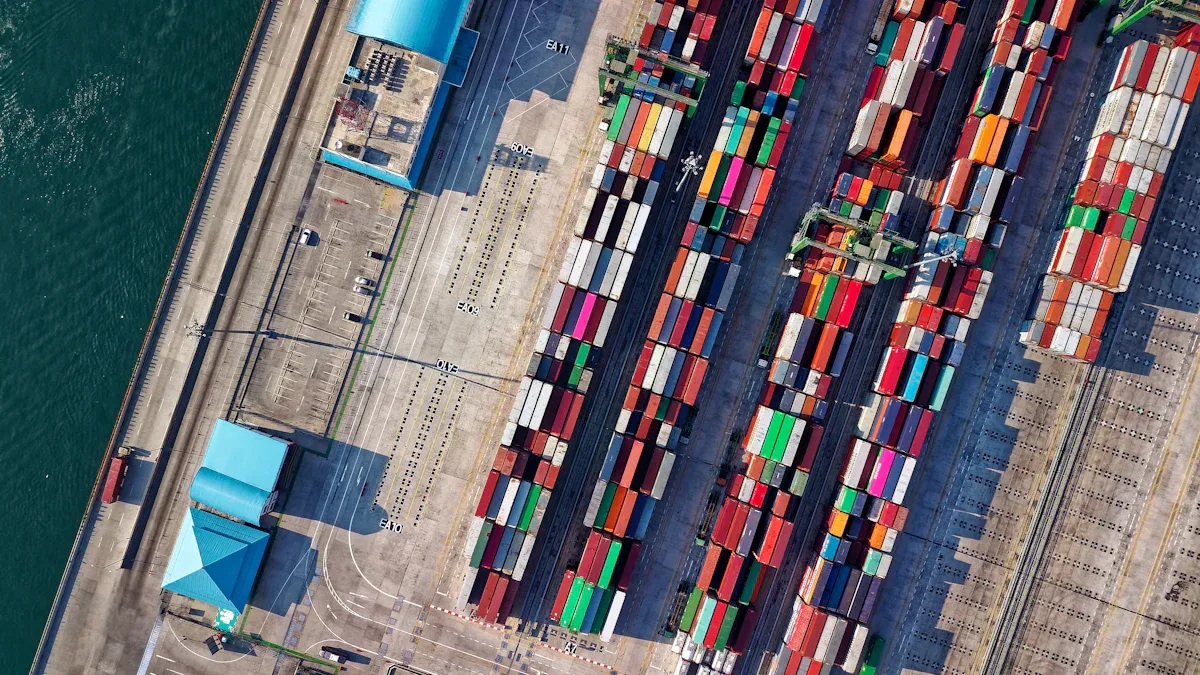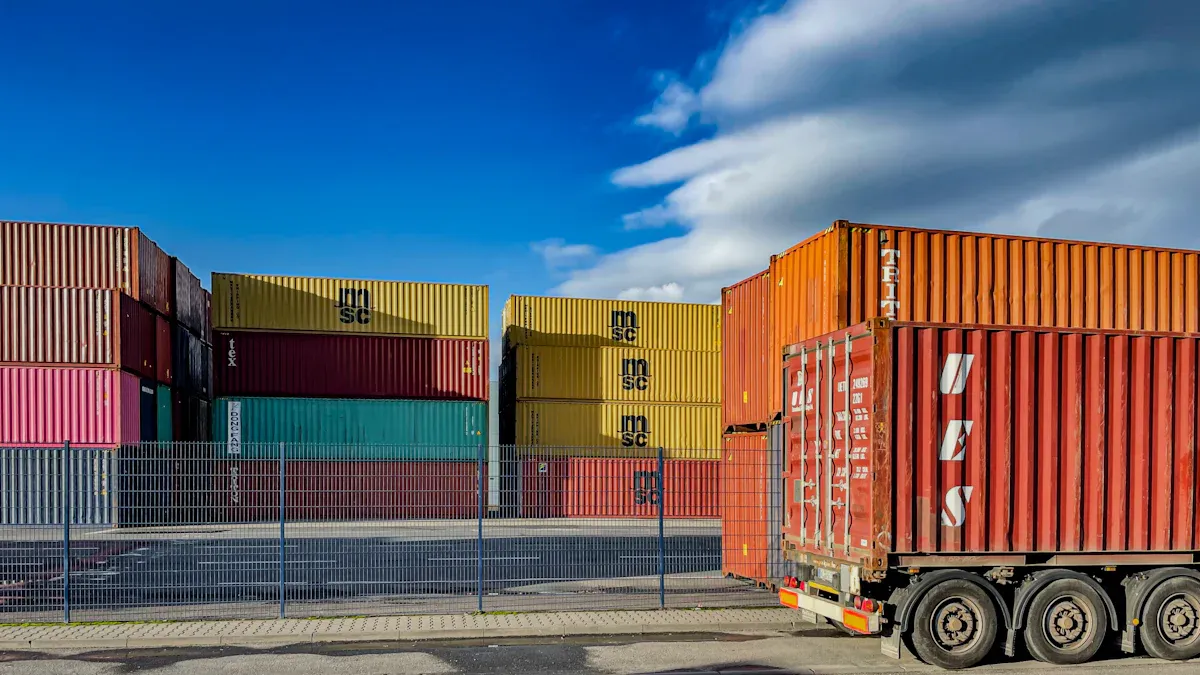What is Factory-Direct Sourcing and How Does It Work

Factory-direct sourcing means you buy products right from the maker. You do not use any middlemen. This way, you get better prices and more profit. Many businesses make more money this way. Some distributors have made almost three times more on big orders by working with factories in other countries. You also get more control over how things are made and tested. You can check the quality yourself. But you also have to handle more risks with quality and supply.
What Is Factory-Direct Sourcing

Key Features
When you use factory-direct sourcing, you buy goods right from the manufacturer. You do not use agents, brokers, or distributors. This way, you have more control over buying products. You can talk to the people who make your items. This helps you set clear rules for quality and price.
Here are some key features of factory-direct sourcing:
You work with the factory to buy products, not with middlemen.
You get more control over how good your products are and how much they cost.
You can build better relationships with suppliers, which helps you plan for the future.
You can watch how things are made and know where your products come from.
You often pay less because you skip extra costs from other sellers.
You can talk about things like order size, payment, and delivery time with the manufacturer.
You check the quality yourself by making your own inspection rules.
Tip: When you use direct sourcing, always add up all costs. This means you count manufacturing, shipping, customs, and checking quality. This helps you avoid surprise costs when buying products.
Differences from Traditional Sourcing
Factory-direct sourcing is different from traditional sourcing in many ways. In traditional sourcing, you usually work with agents or trading companies. These middlemen buy products for you, but they charge extra fees. You might not know which factory makes your products, and you have less control over quality and price.
The table below shows the main differences:
Aspect | Factory-Direct Sourcing (Direct) | Traditional Sourcing (Indirect) |
|---|---|---|
Contract Negotiation | You talk to the manufacturer and set product details, quality, payment, and delivery time. | Middlemen handle contracts. You do not get to decide on many details. |
Quality Control | You make your own inspection rules and check products or hire someone to do it. | Middlemen check quality. You trust their reports. |
Legal Agreements | You sign NDAs and IP protection contracts with the factory. | Middlemen handle legal things. You may not get as much protection. |
Transparency and Control | You know the factory, materials, and how things are made. | You may not know where your products really come from. You have less control. |
Costs | Lower costs per item. No extra fees from middlemen. | Higher costs because agents or brokers add their own fees. |
Relationship Management | You work directly with the factory. | You work with the middleman, not the factory. |
With factory-direct sourcing, you get clearer prices and more control over buying. You can also get discounts for buying a lot at once. In traditional sourcing, you pay more because each middleman adds a fee. You also have less control over quality and delivery.
Note: Direct sourcing is best if you want to manage buying closely and see how things are made. If you want to save money and build strong supplier partnerships, this method can help you reach those goals.
Process
Factory-direct sourcing puts you in charge of each step. You do not use agents or brokers. You handle everything from finding a factory to getting your products.
Finding Factories
You start by looking for factories that fit your needs. First, do some research. Use the internet, trade shows, and business groups to find suppliers. Here are some ways to find good factories:
Look at websites like Alibaba, Global Sources, and Made-in-China to see many suppliers.
Go to trade shows like the Canton Fair to meet factories in person.
Join business groups to get advice and tips from others.
Try sourcing sites like Sourcify or Thomasnet for trusted factories.
Platform | Description | Best For |
|---|---|---|
Alibaba | Big online marketplace with many suppliers in China and Southeast Asia. You can talk to sellers, order samples, or start production. You need to check if suppliers are real. | Companies wanting cheap, large orders for common goods. |
Faire | Wholesale site that links brands and stores in North America and Europe. It has ready-made items, not custom ones. | Stores looking for new products and brands selling more. |
Sourcify | Sourcing site that helps you find checked factories, manage timelines, and see your supply chain. | Brands needing help with sourcing and production, like clothes or packaging. |
Thomasnet | U.S. directory for finding industrial and commercial factories, including packaging and machines. | Buyers who want U.S. factories for industrial or packaging needs. |
After you find some factories, you need to check them. Look at their reputation and money strength. Make sure they can make enough products. Ask for samples and talk to other customers. Visit the factory if you can. See if they talk well and want to meet your needs.
Tip: Use smart tools to find and check suppliers faster. This saves time and helps you compare factories.
Negotiating Directly
When you pick a factory, you start to talk about deals. You discuss price, order size, payment, and delivery. You also set rules for quality. Talking directly gives you more control. You can use your order size to get better deals.
For your first order, show your business can grow. This may help you get smaller order sizes.
For more orders, use your past work to ask for lower prices or faster shipping.
Talk about more than price. Discuss payment, delivery, and quality checks.
If the factory is in another country, remember culture differences. Speak clearly.
Use online tools to see old prices and supplier info. This helps you get ready for talks.
Note: Do not be too tough. Try to make both sides happy so you can work together for a long time.
Managing Production
You must watch the making of your products closely. Without middlemen, you are in charge of timing and quality. Set clear rules and check progress often.
Give the factory your product details and designs.
Have regular meetings to check on how things are going.
Use project tools to follow deadlines and steps.
Ask for updates and photos to make sure things are right.
You can use tech to watch production as it happens. Many companies use special software to track inventory and schedules. This helps you see problems early.
Quality Control
You are in charge of quality control. You must set clear rules and check how the factory does. Here are some good steps:
Tell the factory your quality rules.
Check products while they are being made.
Look at the first batch to make sure it is right.
Hire outside inspectors for fair checks.
Keep track of how the factory does with scorecards.
Use data to find problems and stop defects.
Tip: Check often and talk openly to keep quality high and help your supplier do better.
Delivery
The last step is delivery. You set up shipping from the factory to your place or customer. You must plan well because you do not have middlemen to help.
Use good shipping companies to move your products and handle customs.
Use tech to track shipments and talk to the factory.
Put delivery times and late penalties in your contracts.
Ask for shipping updates often.
Factory-direct sourcing can make shipping up to 40% faster than old ways. You save money and get products quicker because you skip extra stops.
Note: Direct sourcing saves money and gives you more control, but you must handle every detail. Stay organized and pay attention at every step.
Factory-Direct Sourcing Benefits

Cost Savings
You can save a lot of money when you buy straight from the factory. By skipping distributors, wholesalers, and retailers, you cut out extra costs and hidden fees. This makes your supply chain simple and clear. You see exactly what you pay for each part of your order.
You avoid hidden fees like storage, handling, and logistics markups.
You get clear prices from the manufacturer, so you know your real costs.
You can save 20-50% on buying costs by removing middlemen.
You talk directly to the factory, which helps you avoid mistakes and delays.
Orders ship faster, so you spend less time waiting.
Tip: Direct sourcing gives you more power to negotiate better deals and improve your profit margins.
Control and Visibility
When you use factory-direct sourcing, you gain more control over every step. You talk to the people who make your products. You set your own rules for quality, delivery, and payment. You can track your order from start to finish.
You see how your products are made.
You can ask for changes or updates during production.
You spot problems early and fix them before they grow.
You get updates on your order without waiting for a middleman.
This level of control works best for businesses with large order volumes. You can manage big projects and make sure everything meets your standards.
Product Quality
You can improve product quality by working directly with the factory. You set your own standards and check the results. Many top companies use this method to get better products. For example, Apple works closely with its suppliers to improve quality. Apple even helps some factories invest in research and development to meet its needs. Samsung also uses direct sourcing to compare and improve the quality of its processors.
A study on dual sourcing shows that when you work with more than one supplier, you can push each one to do better. You get more control and can keep quality high. In the auto industry, U.S. car makers use direct sourcing with Japanese and Korean firms to get better parts and more choices.
Note: When you manage quality yourself, you can catch problems early and make sure your products match your brand.
Direct Sourcing Challenges
Quality Risks
With direct sourcing, you are in charge of quality. You need to watch for problems at every step. If you miss something, your products may not be good enough. Check the factory before they start making things. Watch how they make your products. Look at the goods before they ship. Each step helps you find problems early and save money.
Risk Prevention Methods | Defect Detection Rate | Cost Impact | |
|---|---|---|---|
Pre-Production Qualification | Test samples, check supplier skills, review processes | High (85-95%) | Low |
In-Process Monitoring | Watch production, do real-time checks, fix issues quickly | Very High (90-98%) | Medium |
Pre-Shipment Inspection | Check finished goods, packaging, and paperwork | Very High (95-99%) | Medium |
Post-Delivery Monitoring | Track product use, collect feedback, fix problems fast | Highest (98-99.5%) | High |
To manage quality risks, train your suppliers well. Use real-time checks and strong inspection rules. Always fix problems as soon as you find them.
Supplier Reliability
You count on your factory to send orders on time. If your supplier has money trouble or is not managed well, your orders might be late or wrong. Check their background and visit if you can. Build a good relationship and talk often. This helps you find problems early and fix them fast.
Ask other buyers for references.
Check if the supplier delivers on time.
Make clear rules for what happens if they are late.
Tip: Good suppliers help your business grow. Pick partners who want the same things as you.
Logistics Issues
Shipping and customs can be hard without help. You must plan each step, from packing to delivery. If you make mistakes with papers or customs, you lose time and money. Use trusted shipping companies and track your goods at every step. Write contracts that say when things must arrive and what happens if they are late.
Add extra days to your plan for delays.
Use technology to track your shipments.
Keep all shipping papers neat and ready.
Direct sourcing gives you more control, but you must handle every detail. Stay alert and act fast to stop costly mistakes.
Tips for Success
Research Suppliers
Start by learning about each factory you might use. Look at their past work and read reviews from others. Ask them to send you samples so you can test their products. Use websites to compare different suppliers. Write down questions before you talk to them. This helps you see if they can do what you need. Doing good research helps you pick the best partner and lowers your risk.
Tip: Always ask other buyers for references. This way, you get honest feedback about the supplier’s work.
Build Relationships
Having strong relationships helps you do better in procurement. Talk with your suppliers often to build trust. Share your goals and listen to what they say. If you can, visit the factory to show you care. Good relationships help you fix problems and make products better. You can also get lower prices and faster service.
Call or message your supplier often.
Give feedback on their work.
Celebrate small wins together.
A good relationship can turn a supplier into a long-term partner.
Use Technology
You can use automation to make buying easier. Many companies use software to track orders and manage inventory. Automation saves time and helps you avoid mistakes. You can set up order tracking, payments, and quality checks to run automatically. This gives you more time to grow your business.
Tool Type | What It Does | Example Use Case |
|---|---|---|
Procurement Apps | Manage orders and suppliers | Track shipments |
Automation Tools | Automate tasks and reminders | Send payment alerts |
Quality Software | Check product standards | Record inspection results |
Note: When you use automation, you get updates right away and have better control over your supply chain.
Factory-direct sourcing lets you have more control and better prices. You can also see how your products are made up close. But you will face new risks. You must handle quality, suppliers, and shipping on your own. To do well, follow these tips:
Use tech tools to watch suppliers and shipments.
Check if suppliers have the right certificates and set clear rules for quality and ethics.
Have backup plans in case there are supply chain problems.
Think about if your business is ready for these jobs before you begin.
FAQ
What is the main advantage of factory-direct sourcing?
You save money because there are no middlemen. You also have more control over quality and delivery. This way, you work directly with the manufacturer.
How do you check if a factory is reliable?
You can ask other buyers for references. You should look at samples and visit the factory if you can. Always check for business licenses and certificates.
Can small businesses use factory-direct sourcing?
Yes, small businesses can use this method too. Some factories will take smaller orders. You might need to talk about the smallest order they allow. Try a small order first to see how it works.
What risks should you watch for?
You should look out for quality problems and late shipments. Communication can also be hard sometimes. Always set clear rules and check products before they ship. Use trusted shipping companies to help avoid delays.
See Also
Understanding Dispensers And Their Function In Manufacturing
How To Collaborate With An Overseas Diecast Factory
Exploring QFD FMEA And DOE Roles In Quality Control
A Guide To Cavity Molds And Their Manufacturing Process
Understanding The Use Of Jigs And Fixtures In Manufacturing
About Hunan Puka
Established in 2016 and based in Hunan, China, with a liaison point in Berlin, we are a Tier 2 supplier for the automobile industry. We specialize in the production of customized aluminum die-casting parts designed for machines with a closing force ranging from 280 to 1250 tons, with subsequent manufacturing process CNC machining and surface treatment. Our commitment to quality is reflected in our accredited quality management system, certified by ISO9001:2015 and IATF16949:2016 standards.


